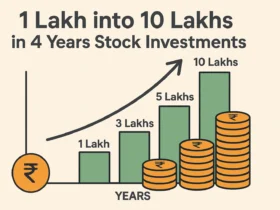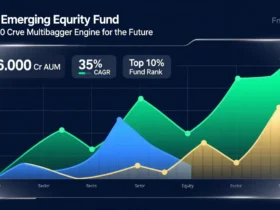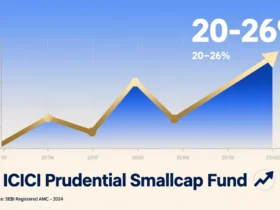What if you could transform mere ₹15,000 a month into a jaw-dropping ₹10 crore over time? For many, this sounds like a fantasy reserved for financial wizards or high-income earners. But with consistency, patience, and disciplined investing—specifically through Systematic Investment Plans (SIPs) in the right assets—this dream is far more achievable than you might think.
Welcome to the world of SIP magic, where steady, modest investments in powerhouse funds can help build life-changing wealth. This blog will take you on a deep, practical, and motivational journey—from understanding how SIP works, to discovering the best avenues for compounding your money, and finally detailing step-by-step strategies to hit that coveted eight-figure goal.
Table of Contents
What is an SIP? Understanding the Foundation
A Systematic Investment Plan (SIP) lets you invest a fixed amount into mutual funds at regular intervals (usually monthly). It is designed for people who want to grow wealth steadily but are wary of market timing. Each SIP installment buys units of your chosen fund, accumulating wealth as you go.
Why is SIP ideal for most investors?
- Rupee-Cost Averaging: You automatically buy more units when prices are low and fewer when they’re high.
- Discipline: SIPs compel you to save before you spend.
- Compounding Benefits: Returns on returns help your wealth snowball.
The Mathematics of SIP Wealth Creation
Let’s break down why SIPs are so powerful. The magic lies in the power of compounding.
If you invest ₹15,000 every month, you’re contributing ₹1,80,000 annually. Over several years, your money keeps earning returns, and those returns keep earning more.
The future value of a monthly SIP investment can be calculated as:FV=P×(1+r)n−1r×(1+r)FV = P \times \frac{(1+r)^n – 1}{r} \times (1+r)FV=P×r(1+r)n−1×(1+r)
Where:
- FVFVFV = future value
- PPP = monthly SIP amount
- rrr = expected monthly return (annual rate divided by 12)
- nnn = total number of installments

How Long to ₹10 Crore? Calculation Example
Assume you invest ₹15,000/month into equity mutual funds, which historically have returned about 12% annually (post-tax). How long before you reach ₹10 crore?
Step-by-Step Calculation
- Monthly SIP: ₹15,000
- Expected Annual Return: 12% (1% monthly)
- Goal: ₹10,00,00,000
Plugging these into the SIP formula and running the numbers shows it would take approximately 28 years to cross ₹10 crore at a 12% annual return. However, if the return is higher (say 14%), the time reduces. Increase your monthly SIP or allocate occasional lumpsums, and you reach the goal even faster.
| SIP Amount | Annual Return | Time to ₹10 Crore |
|---|---|---|
| ₹15,000 | 12% | ~28 years |
| ₹15,000 | 14% | ~25 years |
| ₹20,000 | 12% | ~26 years |
These are estimates—a high return isn’t guaranteed, but equity funds have commonly achieved double-digit annualized returns in the long run.
Choosing Your Powerhouse SIP Investments
The crux of your wealth creation journey is fund selection. With over 1,000 mutual funds in India, how do you choose?
What to look for in “Powerhouse” Funds:
- Consistent Performance: Look for funds with strong long-term (5–10 years) track records.
- Experienced Fund Managers: Tenure and reputation matter.
- Reasonable Expense Ratio: Lower costs = more returns for you.
- High AUM but Not Overcrowded: Funds that are large enough but still agile.
- Alignment with Your Risk Appetite: Aggressive equities for long-term goals; balanced funds for moderate risk-takers.
The Best Mutual Fund Categories for SIP Wealth
Let’s examine the fund categories that have produced ₹10 crore portfolios for disciplined SIP investors.
1. Equity Diversified Funds
Ideal for maximizing long-term returns. They invest across market capitalizations (large, mid, and small caps) and sectors.
2. Flexi Cap Funds
Flexibility to move between large, mid, and small caps allows fund managers to optimize returns during different market cycles.
3. Index Funds & ETFs
These follow market indices (like the Nifty 50 or Sensex) and come with lower costs, making them great for long-term SIPs.
4. ELSS (Tax-Saving Funds)
Offer tax deductions under Section 80C and have the potential for high returns, though there’s a lock-in period of 3 years.
5. Hybrid Funds
For those who want a mix of equity growth and debt stability.
Top-Picked SIP Mutual Funds in India (2025)
Here are some consistently top-performing funds suitable for a ₹15,000 SIP (split across 2-3 funds):
| Fund Name | Category | 10 Yr CAGR (2025) | Key Highlights |
|---|---|---|---|
| SBI Bluechip Fund | Large Cap | ~13% | Top-notch bluechips, stable returns |
| Mirae Asset Emerging Bluechip | Large & Mid Cap | ~18% | Aggressive, ideal for long-term SIPs |
| Parag Parikh Flexi Cap | Flexi Cap | ~18% | Go-anywhere strategy, stellar manager |
| HDFC Index Nifty 50 | Index Fund | ~13% | Low cost, market-matching returns |
| Quant Active Fund | Flexi Cap | ~22% | Contrarian style, high returns but higher risk |
Returns are approximate, based on previous decade’s data as of 2025. Always verify latest numbers before investing.
Expert Strategies: SIP Tips for Wealth Building
- Start Early: Time in the market beats timing the market. Compounding needs years.
- Never Stop During Bear Markets: SIP works best when markets fall (you buy more units at lower prices).
- Review Annually: Check fund performance yearly. Replace laggards with better options if needed.
- Step-Up Your SIPs: As your income grows, increase your SIP by 10–15% yearly to reach your goal faster.
- Diversify Across Styles: Split your SIP among 2–3 funds (different categories or AMCs).
- Avoid Chasing Past Returns: A fund that outperformed last year may not repeat. Look at consistency over at least 5–10 years.
- Reinvest Dividends: Stick to the “growth” option—it allows your money to snowball.
SIP Myths Busted
Myth 1: SIP is Only for Beginners
SIPs are popular with novices, but even the most seasoned investors use them to ride out volatility and ensure disciplined investing.
Myth 2: SIPs Guarantee Returns
SIPs don’t guarantee profits; they simply average out purchase prices and instill discipline. Long-term, equities have rewarded patient SIP investors.
Myth 3: Lump Sum Beats SIP
One-off investments might work in some markets, but SIPs help navigate volatility and prevent poor timing.
Mistakes to Avoid on the ₹10 Crore Journey
- Stopping SIPs During Market Crashes: Most investors panic and miss the opportunity to buy low.
- Not Reviewing Fund Performance: A once-great fund can lose its edge.
- Excess Diversification: More funds ≠ better returns. Three is enough.
- Ignoring Taxation: Understand capital gains tax and how it affects your post-tax returns.
- Neglecting Asset Allocation: If your risk profile changes (e.g. as you near retirement), gradually rebalance towards safety.

Staying the Course: Psychology of Long-Term Investing
Wealth creation is less about choosing the “perfect” fund and more about sticking with your plan. Markets will rise, fall, and test your resolve. The real challenge is discipline and emotional resilience:
- Avoid Checking Daily: Markets will swing; focus on your long-term goal.
- Automate Investments: Set up standing instructions so SIPs run like clockwork.
- Celebrate Milestones: When your corpus overshoots ₹10 lakh, ₹1 crore, acknowledge it—it fuels motivation.
Final Words: The Power of Consistency
Building a ₹10 crore corpus out of ₹15,000 monthly SIPs isn’t a flashy get-rich-quick scheme. It is a slow burn—a marathon of small, compounding victories. But every empire begins with a single, determined step. The phase when you lose patience is the exact moment compounding is about to kick in!
Key Takeaways
- Stick with your SIP, rain or shine.
- Review your funds yearly, but don’t make impulsive switches.
- Step up SIPs as your income grows.
- Trust the process; let compounding do the heavy lifting.
Start today, and let SIP magic work for you. Your ₹10 crore empire is closer than you think—one monthly investment at a time.
Disclaimer: Past returns are not guarantees for future performance. Consult a certified financial advisor before investing. Mutual funds are subject to market risks.
Returns and fund details are based on historical data for leading Indian mutual funds and SIP calculators as of 2025. Always check current performance before investing.
Various SIP calculators and financial planning sources recommend 12%-15% annualized return over decades for aggressive mutual fund SIPs, but past returns don’t guarantee the future.


































Leave a Reply